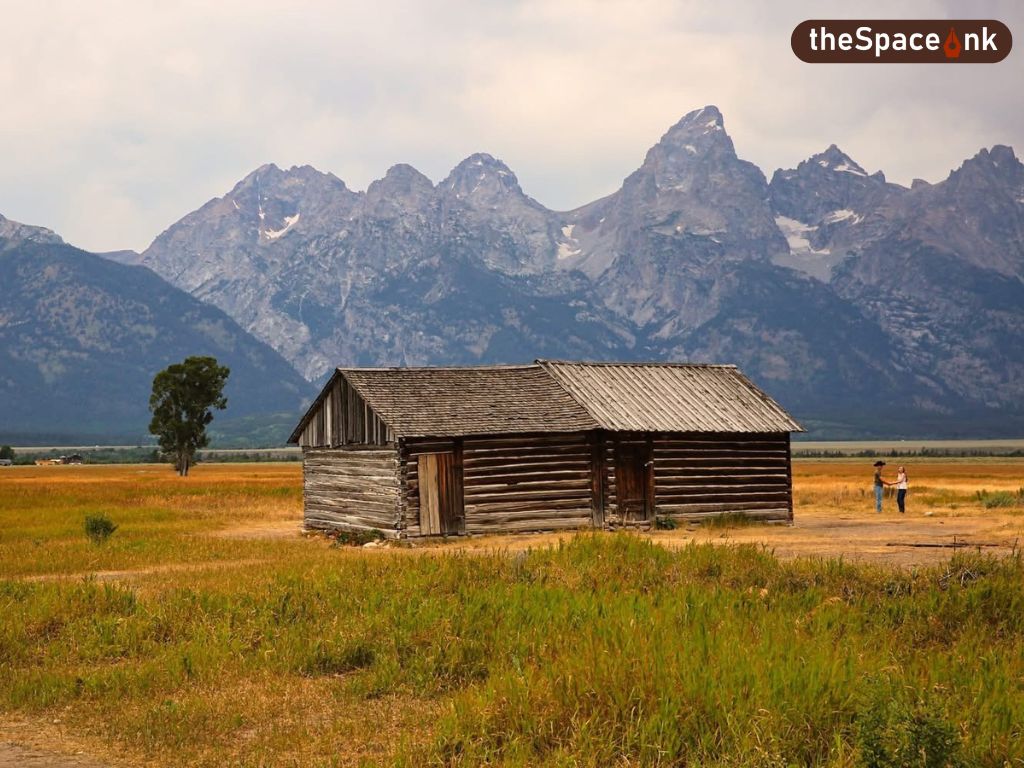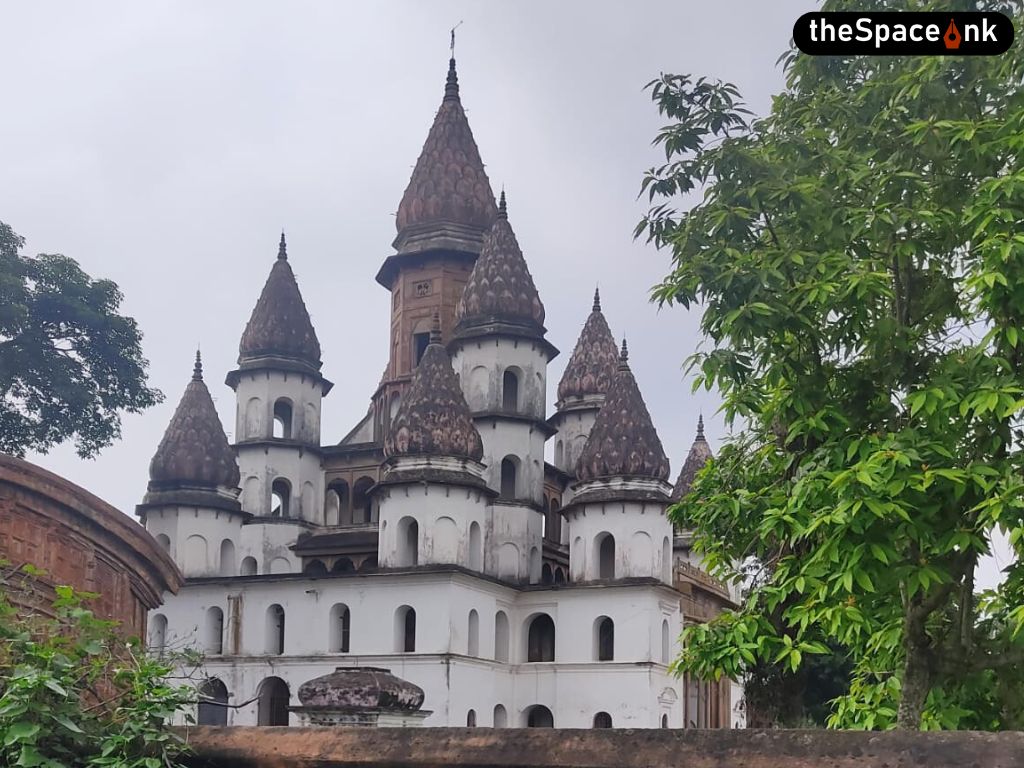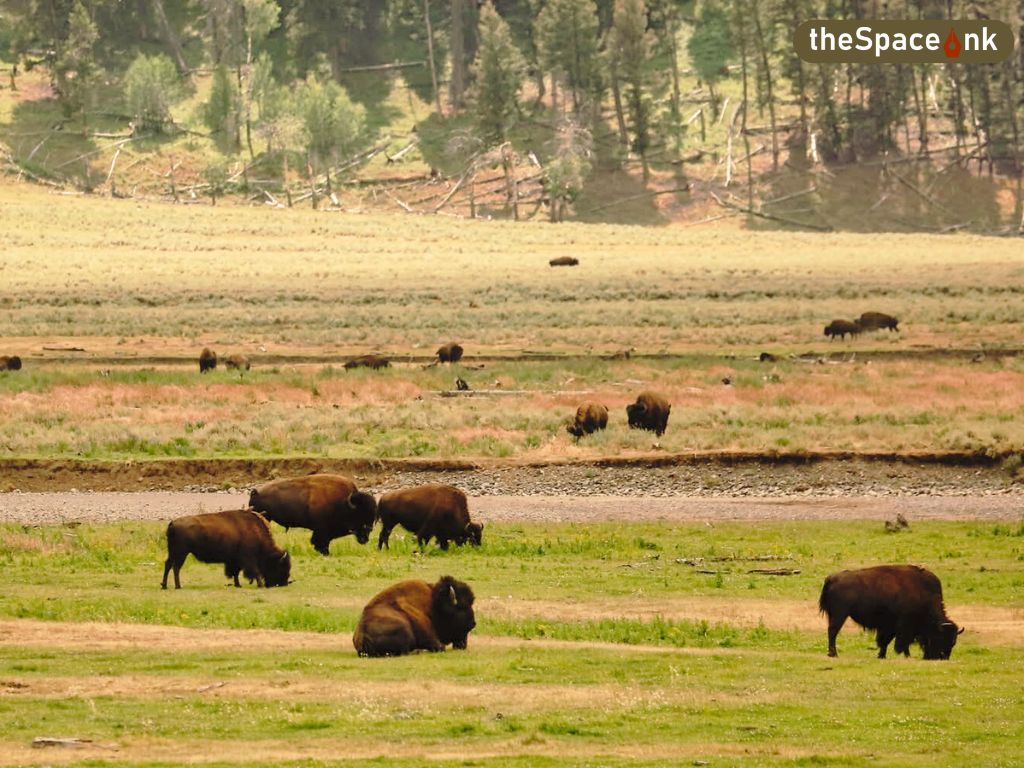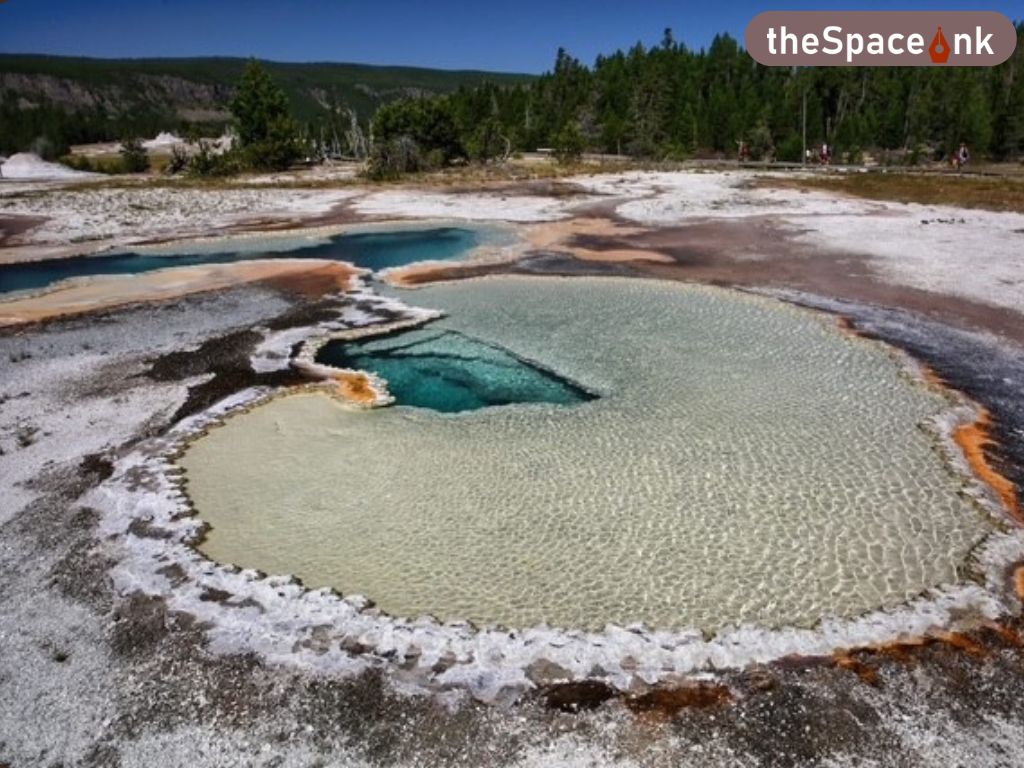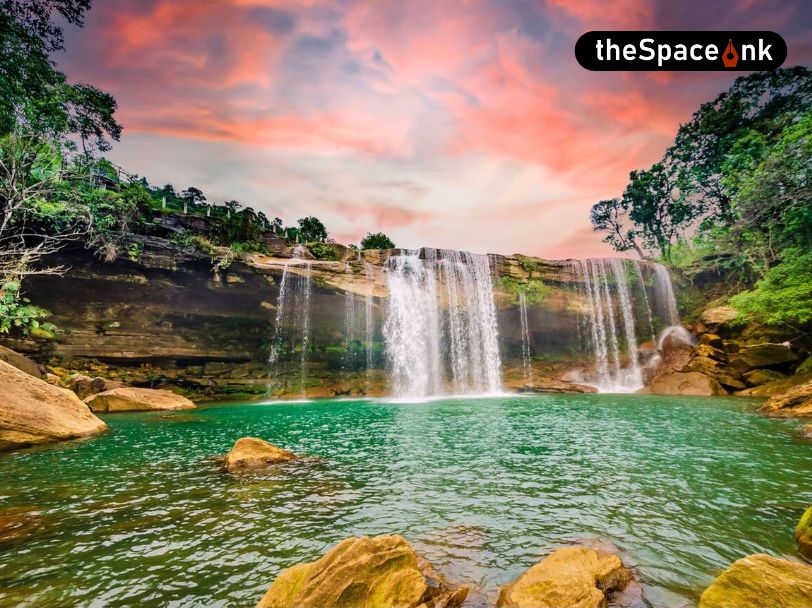(Grand Teton)
The next morning was our last in the park. We packed up and left to stop by a few more spots in the Hayden Valley, at Sulphur Cauldron and Mud Volcano, one of the most acidic areas in Yellowstone National Park. We drove further south and reached the gigantic Yellowstone Lake, fed by several rivers, including the Yellowstone River. The river is a haven for aquatic birds and is prized for Trout fishing.
From the Lake Butte Overlook, we caught a panoramic view of the deep blue Lake, which is as vast as an inland sea, and noticed the lakeside thermals as well as the peaks of the Grand Teton far to the south. Though the water looks inviting, just like many other parts of the park, its looks are deceiving. It’s too cold for swimming.
Also Read: A Journey Back to Self and Nature: Yellowstone and Grand Teton
The Lake’s irregular shape is a result of water filling the craters left by steam explosions, creating odd-shaped bays. Nearby the Lake village is a charming spot with restaurants and lodging. My teenager finally had an opportunity to try a bison hot dog at a retro-faced diner here.
On the Southern border of the Lake is the West Thumb Geyser basin, which was our last stop before leaving the park. The thermal features here are not particularly exciting, but the contrast between the white clay texture of the basin next to the Lake’s vivid blue presents a striking view. There are some unique features, though, like the Fishing Cone, a geyser by the Lake that’s tied to old tales of fishermen boiling their catch right on the line.
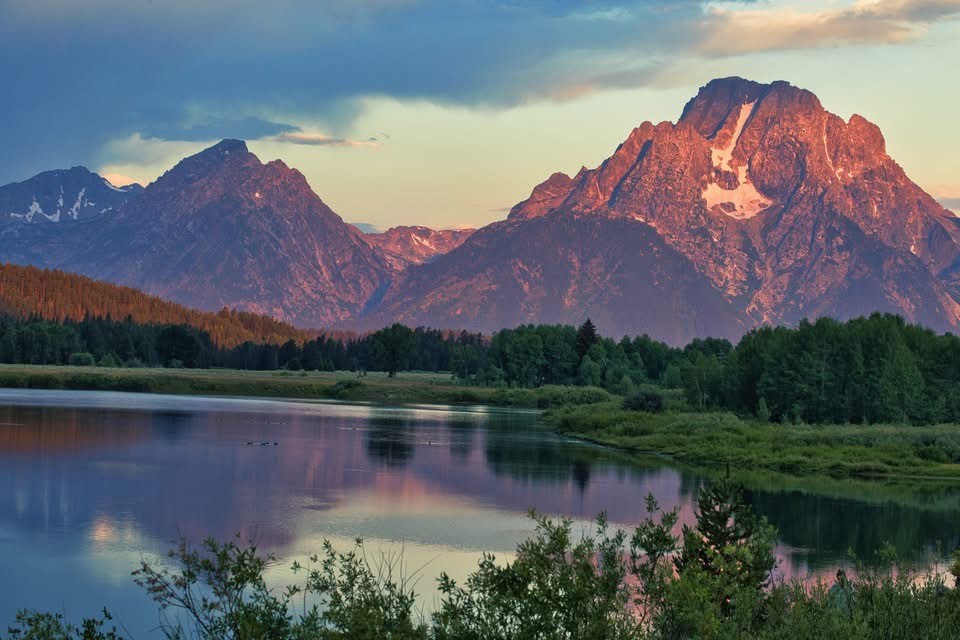
As I bid goodbye to the versatile Yellowstone Park that had not only stirred my heart and soul but also given me a sun rash despite the generous application of sunscreen, I gathered that this park is not for the meek. It changes you and your perception of the planet and nature, humbling all with its magical topographies reminiscent of the ancient past, before humans walked the Earth. It brings out the truth-seeker from within, awakening us to the fact that we and our egos are small and insignificant compared to the vast scope of nature and its infinite abilities.
“One of the reasons why the Teton range stands out is that, unlike other great mountain ranges, the Teton rises steeply from the flat valley floor in a straight, unbroken line.”
Grand Teton
We had left behind a throbbing, growling ecological and geological wonderland, not meant to soothe but to amaze travelers with its intense features. We were now gathering speed on the Rockefeller Memorial Parkway that connects Yellowstone to Grand Teton National Park. This parkway honors the contributions to conservation made by the Rockefeller family. Visiting Jackson in the 1920s, John Rockefeller Jr. was dismayed by the slipshod development that he felt was spoiling the landscape. With a vision to protect the spectacular Teton scenery, he began purchasing land around it, and later donated over 30,000 acres of the valley to the federal government to ensure public access to the views of the Teton Range. (Grand Teton)
Also Read: Grand Canyon of The Yellowstone (Part 2)
Soon, we caught a broad view of dramatic jagged peaks soaring upward into the Western sky. One of the reasons why the Teton range stands out is that, unlike other great mountain ranges, the Teton rises steeply from the flat valley floor in a straight, unbroken line. We stopped to meet our friends at the Jackson Lake Lodge, which has the most stunning view of the range. The sunny afternoon slipped into a pink-gold evening as we sat sipping iced tea at the bar area outside. (Grand Teton)
Over the next two days, we saw the range from multiple angles, in different lights depending on the time of the day, reveling at its towering pinnacles, saw-toothed ridges, and deep U-shaped canyons.
“We lunched at Signal Mountain Lodge’s dining room with a magnificent view of Jackson Lake, which is much larger than Jenny Lake, with another breathtaking angle of the Teton range.”
Jenny Lake: Grand Teton
Although there are several tree-lined, sparkling lakes in the park, big and small, the one that receives the most attention is Jenny Lake, which is considered the park’s centerpiece. It’s a hiker’s delight, offering short trails to Hidden Falls and Inspiration Point, as well as Cascade Canyon. There are longer trails that loop around the Lake, which provide access to Lake Solitude or Hurricane Pass. Then there are options, like a boat shuttle for lazy tourists like me, which takes less than fifteen minutes and provides quicker access to Hidden Falls. I saw some visitors swimming, canoeing, and paddle boating in the Lake as well. (Grand Teton)
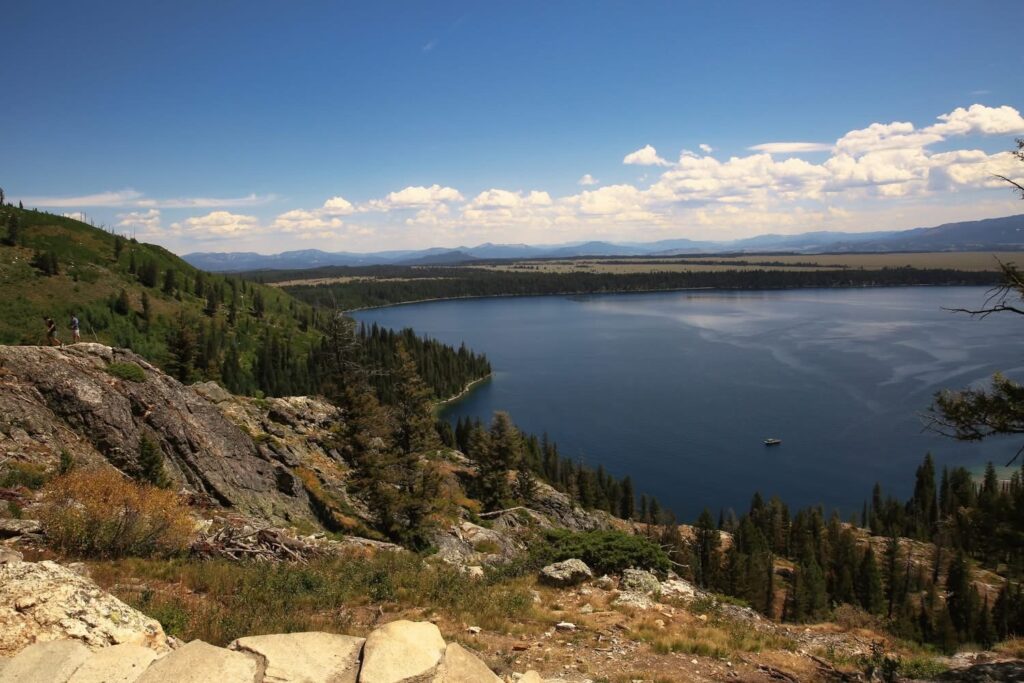
On my short hike to Hidden Falls and halfway to Inspiration Point, I had the chance to observe the mountain more closely, noticing outcrops of sugary white granite, glittery mica-studded dikes, and dark grey-colored layers of rock.
The glacial Lake is unique, given its serene appearance at the foot of the Teton Range, its crystal-clear water, and the alpine vegetation surrounding it. Against the backdrop of a brilliant blue sky with flecks of ice still clinging to the higher cliffs, the sight is oddly calming and exhilarating at the same time. (Grand Teton)
We lunched at Signal Mountain Lodge’s dining room with a magnificent view of Jackson Lake, which is much larger than Jenny Lake, with another breathtaking angle of the Teton range. After which we drove up a narrow, winding road to Signal Mountain summit and caught a bird’s eye view of Jackson Lake and the broader Jackson Hole valley.
Driving south, we stopped at several turnouts, such as Cascade Canyon Turnout and Teton Glacier Turnout, as the sun hit the range at different angles. We were rewarded with awe-inspiring views of the topography born out of an ancient past and shaped by recent geological forces.
“The next morning, we walked around the charming Teton Village, drank several cups of coffee, and took the aerial tram to the top of Rendezvous Mountain at 10,455 feet.”
As we stopped for water and to photograph the range, a quick read of the park brochure informed me that, over billions of years, natural forces—such as earthquakes, glaciers, and erosion—had shaped this magnificent landscape. The Teton Range contains some of the oldest rocks in North America. These rocks were formed when sea floor sediments and volcanic debris were buried up to 18 miles deep as two tectonic plates collided – a process similar to the collision of India and Asia today, which forms the Himalayas. (Grand Teton)
Yet, the Tetons are one of the youngest mountain ranges in North America. They have been uplifting for less than 10 million years, making them “adolescent” mountains, compared to the “middle-aged” Rockies, which are 50-80 million years old, or the “elderly” Appalachians, more than 300 million years old. Erosion has had much less time to work in the Tetons, comparatively, so their jagged peaks remain standing high.
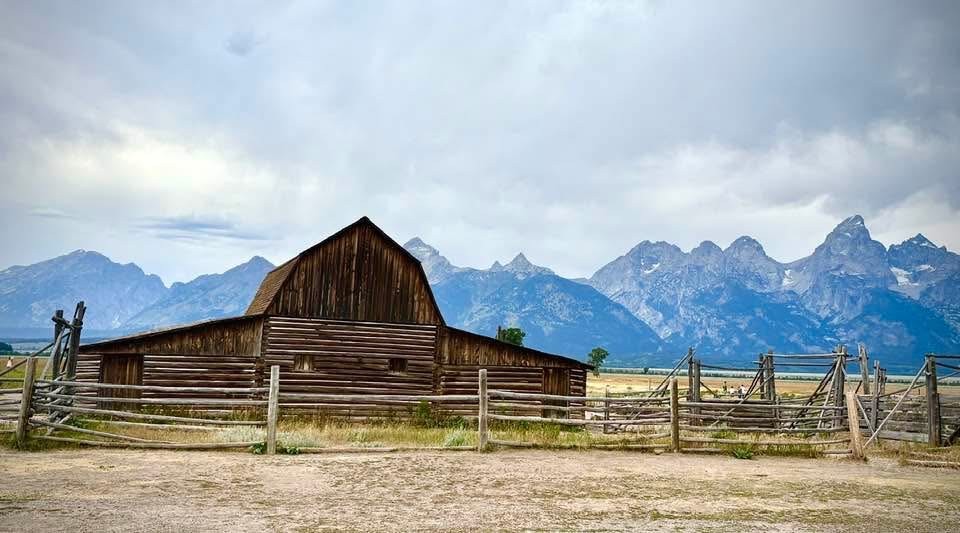
Mormon Row: Grand Teton
We reached the southeast corner of the park, known as the Mormon Row Historic District, which consists of a line of homestead complexes. It is an eerily beautiful part of the park. The textured, rugged old wood of the barns from a bygone era, set amidst miles and miles of rolling grasslands, against the backdrop of the grey-blue Grand Teton, is so picturesque that it has drawn artists and photographers from all over the world.
Mormon settlers chose this location in the 1890s for its fertile soil, shelter from winds, and access to the Gros Ventre River, which provided a vital water source for irrigation. While the community thrived for decades, many families eventually sold their land to the National Park Service and moved away. Some descendants of the original owners still reside in the area.
“The shore was dotted with yellow and purple wildflowers, and the entire scene was very tranquil. I wished for a moment that I could bottle the sounds and sights and stash them for more chaotic moments in life.”
With our hearts full of magnificent views, lakes, and mountains, and ancient stories of the collision of tectonic plates and glaciers, we retired to Teton Village, south of the park. We treated ourselves to cocktails and nachos at the lively Mangy Moose to fathom what we had learned and seen.
The next morning, we walked around the charming Teton Village, drank several cups of coffee, and took the aerial tram to the top of Rendezvous Mountain at 10,455 feet. Whether you take a short hike or soak in the view of the mountains from the Grand Teton Skywalk or sit on a chair outside, filling your lungs with the cool mountain air, you cannot leave without trying the gourmet waffles at the rugged Corbett’s Cabin, which are called “top of the world” for a good reason. (Grand Teton)
Also Read: Reverie of a Pluviophile: Exploring Magical Meghalaya
Colter Bay Marina: Grand Teton
With our bellies full, we reentered the Grand Teton park and headed to Colter Bay Village, nestled at the shores of Jackson Lake. Our teenager wanted to lead the activities for the day, so we let him decide what to do once we reached the Marina. All the boats were out, which was disappointing, but that gave us a chance to walk around the area and catch the excitement and chatter at the dock as small groups assembled for conducted boat tours.
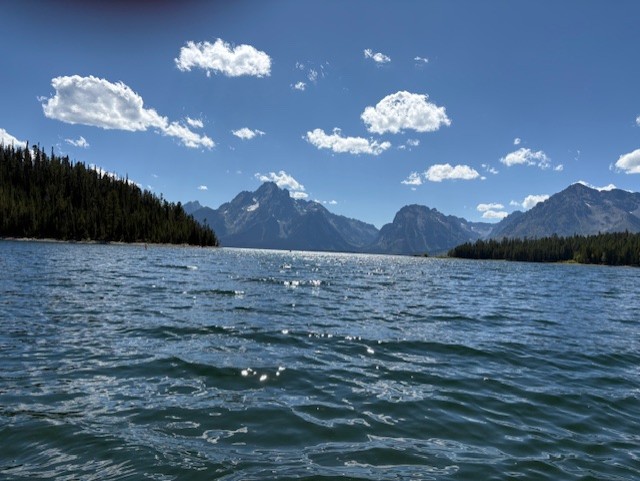
In an hour, one of the canoes returned, much to my son’s delight. After a brief tutorial from the boat rental instructor, we strapped on orange life jackets and steered the initially wobbly canoe through the water that looked deep and green-blue. We paddled around for an hour in the calm waters. The shimmery afternoon Lake and the sound of waves lapping gently against the shore were soothing. (Grand Teton)
They were perfectly complemented by a clear and direct view of the Teton Range, which felt omnipresent in the park, like a benevolent guardian angel watching over all. The shore was dotted with yellow and purple wildflowers, and the entire scene was very tranquil. I wished for a moment that I could bottle the sounds and sights and stash them for more chaotic moments in life. However, the best experiences can never be stored, but must be lived in.
“The next morning, as we drove back to Salt Lake City to take the flight home, the experiences of the last six days washed over us like a fast-moving slide show.”
Later, as we took the Teton Park Road back to the South entrance, we stopped at the Chapel of the Sacred Heart, a rustic all-log cabin near the Jackson Lake Dam. The setting of the chapel, built in the 1930s, was so serene that it drew us to it; its most remarkable feature being the set of stained glass windows with views of the national park’s landscape. It felt like the perfect place for reflection and to feel a spiritual connection with the almighty nature. (Grand Teton)
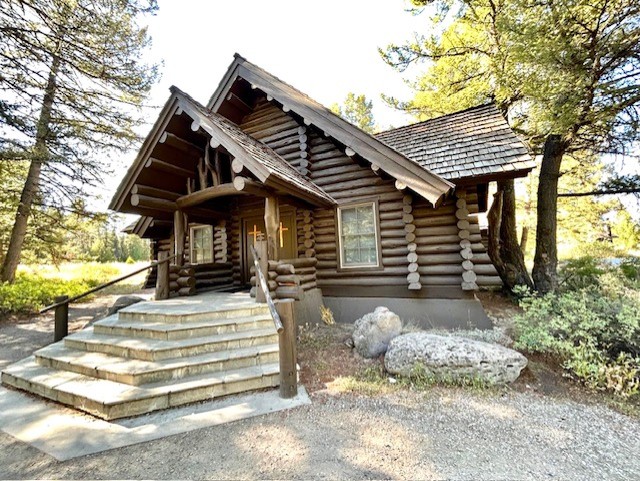
We were running out of time and had less than half a day left to explore Jackson Hole. So, we gave one last bow to the Teton Range and took the highway to Jackson. Having spent the last five days immersed in nature, it took us a while to adjust to the bustling town of Jackson. The town square has evolved from a dusty frontier gathering spot into a vibrant center known for its striking elk antler arches.
The famous Million Dollar Cowboy Bar, a landmark since 1937, horse-drawn stagecoach rides around town, and the Jackson Hole rodeo perfectly fit into the quintessential American West experience for tourists. The larger Jackson Hole area is also a winter wonderland, attracting skiers and snowboarders.
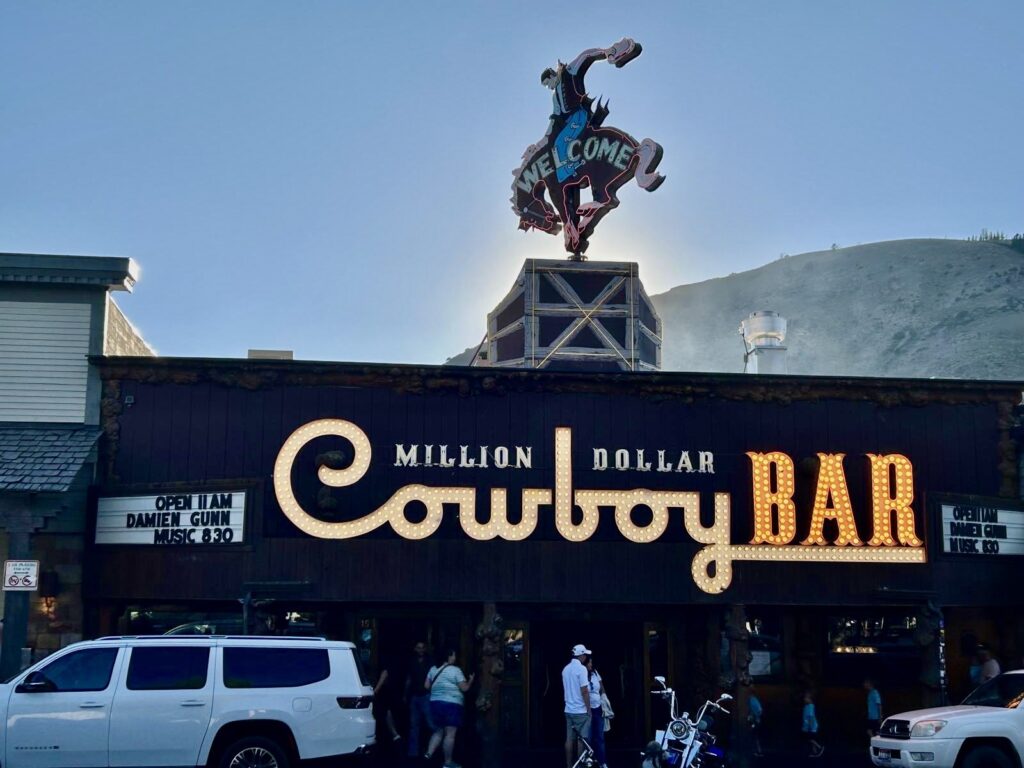
The untamed beauty of Wyoming has such a tremendous power to move people that even oil and business tycoons, like John Rockefeller Jr., who discovered the superlative views of mountains and lakes, fell in love and pledged to protect them.
The next morning, as we drove back to Salt Lake City to take the flight home, the experiences of the last six days washed over us like a fast-moving slide show. This unique interconnected ecosystem of Earth, sky, and water in the greater Yellowstone area, which includes both parks, has inspired men to return to nature what they had taken away for settlement.
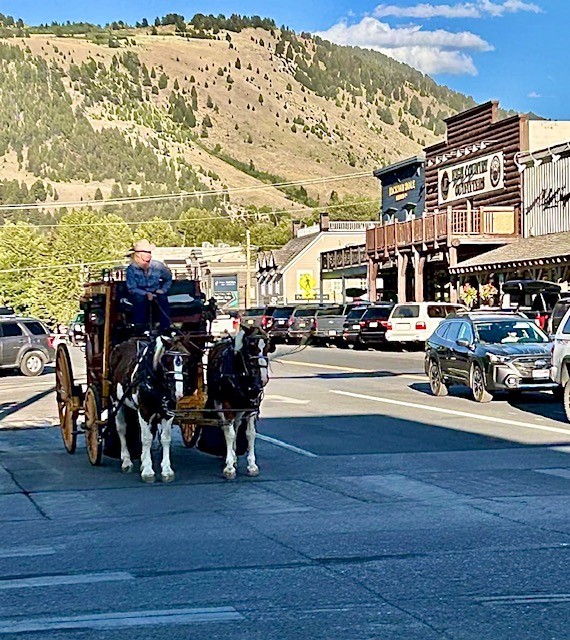
It instils in us the hope that even in these times of extreme greed and hostile takeovers, there is still the will to preserve nature in its purest form. It’s one of the rarest places on Earth where all the native wildlife species from here—pronghorns, elk, moose, wolves, bears, and bison– are still walking upon it.
Also Read: Hopelessly Lost in Paris
It reminds us that something as pure and massive as Earth’s natural wonders can only be experienced in person by traveling there. To awaken the human spirit on a grand scale, matching the soul and spirit of nature, and to rediscover humility and pure bliss, one must walk back to the past, to oneself and nature.
Photos by Shubhankar Chowdhury
Sreya Sarkar is a freelance writer based out of Massachusetts, with her fingers dipped in multiple writing projects. A public policy professional by training, she writes socio-political columns for Indian news magazines like The Quint and Dainik Bhaskar. She also pens short stories for literary magazines.


